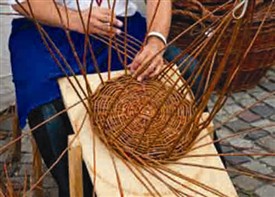The Willow Holts of Farndon

Typical basket-weaving today
P. Ingall
A time When Willow Holts Lined the River Trent
By Philip Ingall
Basket weaving is one of the widest spread crafts in the history of any human civilization, (writes Philip Ingall in the June 2014 issue of Farndon Focus),
It is hard to say just how old the craft is because natural materials like wood, grass, and animal remains decay naturally and constantly. So without proper preservation, much of the history of basket making has been lost and is simply speculated upon.
Basket weaving is part of the history of the River Trent for there was a time, history tells us, when every village alongside the river had a willow holt. Farndon was no exception. In fact it had two. The larger one was the Farndon Ferry Holt which covered some 11 acres and is one of the few remaining survivors of the working willow holts. The other one was at the side of the Fosse Road (the former A46) between Farndon and Thorpe, this latter one growing mainly hard willows.
Many different varieties of willows were grown for different purposes in the basket trade. Basket willows were called osiers when growing and rods when they were cut. There is now a residential road called The Osiers on the Newark roundabout side of the controversial Farndon Road roundabout.
They were cut every two or three years depending on the type of rod required. “Feeling” the rods after retting (soaking them in water) was done by women. The rods were usually retted in the river and, where Farndon was concerned, peeled in a field next to where the baskets were going to be made. They were then laid on racks to dry. Hampers and shopping baskets were made from unpeeled rods.
A row of newly pollarded willows
P. Ingall
When a tree was pollarded and this exercise can be seen on Wyke Lane near to the Riverside Restaurant, they were cut some ten feet from the ground and the “crack willow” produced was used for fencing.
Varieties of willow bore fascinating names such as “Black Maule”, Spaniards” and “Wissenders*.
Busy Factory
Horace Mills together with Frank Foster came from Southwell to establish Mills basket making factory in what used to be Thorpe’s flour mill. A good many people worked there and in the years prior to 1922 it was like a beehive with people working at full stretch. The factory’s manufacturing included linen lined baskets, hampers and also it fulfilled Post Office and Army contracts.
In 1922 Horace Mills left to become a teacher at the Hull Institute for the Blind. Mr Frank Foster and his son George who had both worked for Mills started work on their own in 1919 in the butcher’s shop on Main Street which later became the post office. The trade declined and in 1924 George followed his former boss to teach basket making for the blind,
Farndon’s Willow Holt of today, is the result of re-instatement work by the late Lever and Brenda Howitt, after the Second World War. It is especially important as it houses a diverse collection of willow varieties and hybrids. On his death the site came into the hands of the Nottinghamshire Wildlife Trust which is constantly working to restore it to its former status.
In recent years cricket bat willows growing on the reserve have been harvested to make bats and the famous Gunne and Moore name has graced more than a few bats made from willow gathered at Farndon.
In 2010 invasive Himalayan balsam infested Newark’s Willow Holt and Hebridean sheep were grazed there to suppress it. Nottinghamshire Wildlife Trust said “the sheep far exceeded our expectations, and this is clearly a very effective way to tackle what is in many areas a major problem.
That willow holts ceased to exist was due in the main to imports of ready-made baskets from abroad and also the innovation of more mechanical methods of manufacture. It was largely what could well be described as a cottage industry and gave employment to those people who lived in close proximity to the holts.
This article first appeared in the june 2014 edition of 'Farndon Focus' village newsletter, and is reproduced here by kind permission of the author and editor. www.farndonfocus.co.uk
*